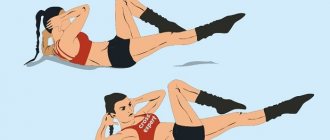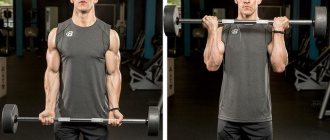Have you noticed that many bodybuilders of old, such as Arnold Schwarzenegger, had a completely flat, almost concave stomach?
Having a big, bulging six-pack is important, but having a shocking ratio of torso width to narrow waist is even more important. After all, then your muscles will become, in fact, noticeable and pronounced.
Legends say that athletes of those years used special, even slightly unusual, exercises for this.
They are called "belly vacuums." Their beneficial properties include not only a beautiful retracted abdomen, but also strengthening the spinal support system, which will allow you to soon become stronger. It will be easier to lift weights, and the risk of you getting injured during exercise will be reduced.
Vacuum exercises are described in many ancient texts about Yoga. They are practiced in either of two forms: Uddiyana Bandha (breathing exercise with abdominal contraction) and Nauli (toning and cleansing exercise).
Arnold Schwarzenegger described this technique as both a bodybuilding pose and a technique for maintaining a flat stomach.
If you want to learn how to use this secret exercise of legendary bodybuilders and use it to achieve a narrow waist, then you are in the right place. We will tell you and show you how to properly make a vacuum in different variations, and you just have to choose the most suitable one.
The magic of vacuum exercises (in several illustrations)
What's so special about it?
Traditional ab workouts give you a six-pack and slightly tighten your stomach because the superficial muscles (rectus and obliques) are worked. The “Vacuum” for the abdomen will help you remove fat folds and get a slender waist, reviews of which we will look at below.
This means that the essence is to pump up the internal transverse muscles, which give that coveted curve of the waist. The deep multifidus muscles are also trained, thanks to which we achieve a flat stomach and graceful posture. First, let's talk about contraindications.
Why pumping up your abs is not enough
In the human body there are four groups of muscles that form the abs: straight, oblique (internal and external), as well as the deepest - transverse. They are interconnected, and each is involved in creating the press. The emphasis of the load is shifted to the desired abdominal muscle.
By performing traditional abdominal exercises, the rectus and oblique abdominal muscles are loaded. They provide body movement and are responsible for aligning the contour of the sides, forming the coveted cubes, and sculpting the figure. The transverse muscles are also involved, but their task is to support the internal organs and spine in a natural position. This muscle group is responsible for keeping the waist narrow and the stomach reduced in volume.
Regular abdominal training is useful, but only exercises to develop the transverse abdominal muscles will give a “flat” result.
Benefits and harms
In addition to losing weight and strengthening underdeveloped abdominal muscles, exercise has a general healing effect on the body. When performing a vacuum, the following positive effects appear:
- the functioning of internal organs is improved;
- digestion and intestinal function are stabilized;
- blood supply improves;
- the lumbar region is strengthened;
- toxins are eliminated;
- posture is corrected.
Vacuum exercise is especially useful for women: it is a good prevention of congestive processes in the pelvis, increasing the body's resistance to stress due to its beneficial effect on the nervous system, and improving sleep quality. Abdominal vacuum exercise allows you to recover faster after childbirth.
Contraindications to abdominal vacuum exercises include gastrointestinal diseases and problems of the genitourinary system. It is dangerous to make a vacuum if you have a peptic ulcer of the stomach and duodenum. Harm is possible during menstruation and pregnancy. You should not do the exercise if your stomach hurts. If pain is persistent, you should consult a doctor.
Who should refrain from “Vacuum” for the stomach: reviews
Unfortunately, not everyone can do it. It is forbidden:
- Pregnant women and women after cesarean section. You must wait until the discharge stops.
- People with respiratory and cardiovascular diseases.
- If there are any problems with the gastrointestinal tract.
- During the menstrual cycle (especially if it occurs with pain), and a week before it, if the discharge is usually scanty.
- When there are any neoplasms on the pelvic organs, for example, the uterus, or inflammatory processes.
After giving birth, you can start exercising 6–8 weeks later. If pain or any discomfort appears, you should stop training. It’s better to consult a therapist in advance.
One woman started exercising after giving birth, and the results were not long in coming. After a month of training, she was able to tone her muscles and lose three centimeters from her waist. An exercise that seems easy at first glance does not always work out right away. Let's talk about what beginners should focus on.
Useful tips
They will help you learn how to do the exercise correctly:
- Don't exhaust yourself. Take 40 seconds between sets.
- You need to train on an empty stomach. If you have had breakfast, you should wait two and a half hours, and it is better not to gorge yourself on meat, but to fill yourself up with a light vegetable salad.
- Don't be afraid of dizziness. You may also feel sleepy and yawn. This is because the body is not accustomed to this exercise, which fully saturates every cell of the body with oxygen, which was previously lacking. After regular training, these symptoms will disappear.
- But if a tingling sensation appears, you should stop, because it arose due to improper execution.
- And it’s better to start with ten seconds, gradually increasing the load.
You should not expect quick and colossal results; this may take up to six months. But the main thing is not to stop. There is an effect from the “Vacuum” exercise for the abdomen, reviews and photos confirm this.

How to do it?
- Feedback from practitioners suggests that the most popular position for performing the exercise is the “Cats” pose.
- So, get on all fours, looking straight ahead.
- Inhale as much air as possible, and then exhale forcefully and draw in your stomach as much as possible, trying to hide it under your ribs.
- Hold this position for 5-10 seconds. Do not try to withstand too much at once, as this can lead to dizziness and even loss of consciousness.
- Do the vacuum 10 times, and then rest for a minute and perform 1-2 more sets.
- When you accustom your body to this exercise, you can change your position. For example, try doing a vacuum while standing or lying on your stomach. The last option is the most difficult and is suitable only for those who know how to pull their stomach under their ribs in the “Cat” pose.
If you want to make the exercise even more challenging and achieve better results in building a flat, toned stomach, you can do five-stage breathing from the Bodyflex weight loss system.
Correct technique from trainers: video
We invite you to watch a video on how to properly make a vacuum. We have selected for you several videos with a classic version of the exercise and a whole mini-set of classes based on the abdominal vacuum technique. In the video you can see and photo the results of the experiment participants who became slimmer.
A little about the advantages
Having talked about contraindications, let's briefly go over the advantages:
- The saggy belly goes away.
- The waist is noticeably transformed.
- The fat that envelops the internal organs melts.
- The deep abdominal muscles are strengthened.
- Posture improves and back pain decreases.
- Hernias are prevented and the abdominal organs are massaged.
- The gastrointestinal tract begins to work better, the problem with constipation disappears.
- Metabolism improves and toxins are eliminated.
This exercise has many advantages. Therefore, if there are no contraindications, you can immediately begin to implement it. Let's see the results of the "Vacuum" abdominal exercise in the "before and after" photo. The reviews speak for themselves.

Why exercise is effective for weight loss
The “vacuum” exercise has come into widespread use in fitness and bodybuilding from yoga. Its meaning lies in a clear study of the transverse abdominal muscle, which is responsible for holding the internal organs of the abdominal cavity. Regular exercises usually lead to the fact that due to pumping up the muscles, the waist increases, but thanks to the “vacuum” the opposite happens - centimeters disappear from the waist, and at the same time the stomach becomes flat and attractive.
As for losing weight, it is worth noting that fat in the body is divided into two types. The first is adipose tissue, which can be observed under the skin, and the second is visceral fat, which surrounds the internal organs, covering them with a layer of varying thickness. If there is a large amount of the second type of deposits, the stomach can be bulging even in thin people, as the muscles simply weaken. It is in this aspect that this exercise helps, tidying up muscle tone and ensuring a flat stomach.
And three more important tips
These recommendations must be strictly followed:
It is necessary to breathe correctly. This is the main and most important stage in the exercise, on which the entire event and the final result will depend. Let's move on to the techniques:
- The first thing we do is take a deep breath, mind you, through the nose. Then exhale (vigorously, strongly) through the mouth, just as deeply, until all the air is released from the respiratory tract.
- There is a second way - the bodyflex technique. First, pursing your lips like a tube, slowly blow all the air out of yourself with your mouth. Then we noisily take a sharp breath in through the nose, and just as quickly exhale it again through the open mouth, the sound “groin” should be heard. And we pull the stomach towards the spine.
Relaxation. Also an important point. After exhaling, you cannot completely relax your abdominal muscles. The effectiveness of the exercise will depend on this.
Technique "Lying"
- You need to sit comfortably on the mat, bend your knees, and straighten your arms or extend them along your body, as convenient.
- Slowly take a deep breath.
- Then there is a quick exhalation, until complete emptying, and, being at this stage, we strongly draw in the stomach so that it feels as if the navel is stuck to the spine.
- Hold your breath for 10–15 seconds. It may not work out at first, no big deal. Breathe a little, but do not relax your abdominal muscles.
- After taking a small breath, take your time to relax, tense your muscles again and hold the pose for 10–15 seconds. If it becomes difficult, take a few small breaths. Exhale, relax.
- Then we take a breath, normalize our breathing and exercise again, performing 5 approaches, 3 for beginners.
Thus, this version of the “Vacuum” exercise for the abdomen, according to reviews, gives a good start and results.

Alternative exercises for a flat stomach
There are several good alternative exercises for pumping up the transverse abdominis muscle that will help you get beautiful abs without performing a vacuum.
If you regularly perform the exercise and do not see results, or the “abdominal vacuum” simply seems uncomfortable to you, then there are many other alternative ways to engage the same muscles.
In addition, it is even useful to use these exercises, supplementing the “abdominal vacuum” with them, because variety is always more beneficial. Muscles develop better if they are influenced from different angles.
If you're looking for other ways to engage your transverse ab muscles without using a vacuum, then you might want to try:
Plank

Lie on the ground and move into a push-up position. Keep your back straight, tense your torso and draw in your stomach. The body from crown to heels should be one straight line. The gaze is directed forward.
Maintain this position for as long as possible! 30-60 seconds is approximately enough. You can even put a weight on your back (if you have a partner) to make the plank even more difficult.
Gluteal bridge
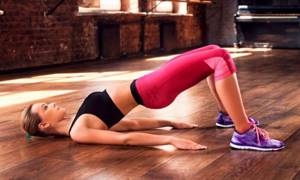
Lie down on the floor. Bend your knees. Move your legs so that they are directly under your knees so that your shins are perpendicular to the floor. Place your hands along your body, palms down.
With your hands firmly planted on the floor, lift both your butt and hips into the air, keeping your back straight. Try to raise your pelvis as high as possible and squeeze your buttocks.
Hold for 1-3 seconds, then lower back to the starting position.
This exercise is good for the buttocks, lower back, torso and legs. Weight can also be added to increase intensity. Place a barbell plate on your stomach.
Russian twist
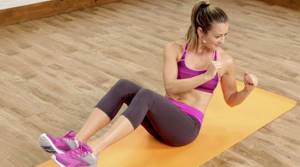
This is a very complex and dynamic exercise that targets the rectus and oblique abdominal muscles. If you can do it correctly, then you have a strong core.
Sit on the floor to start. With your feet in front of you and your knees slightly bent, lift your feet off the floor a few inches. Straighten your back and move it back slightly so that your torso and hips form an angle.
At this point you should be sitting on your buttocks.
Now swing your torso from side to side, keeping your arms in front of you. Try to make the swing angle larger, and you will soon notice a strong burning sensation in the muscles of the abdomen and sides.
Perform several sets of 15-20 repetitions, depending on your level of training.
"Vacuum" for the stomach "Sitting"
It is complicated by the involvement of the spinal muscles. It should be performed on a hard surface, if it is a chair, do not lean against a support, put your hands on your knees, place your legs at right angles, your chin should look down without pressing to your chest. Having taken the starting position, we perform the same breathing technique:
- release air;
- tighten the stomach;
- hold our breath;
- rest and then repeat 5 times.
To avoid the temptation to lean back in your chair, it is better to use a stool, but a stable one. The “Vacuum” exercise for the abdomen, according to reviews, gives good results and quite quickly. The main thing is to follow the instructions.
Exercise in the “Standing” position
Can also be used by beginners. So, the technique:
- Let's get straight. The body should be absolutely relaxed, the knees are soft, the shoulder blades are not tight, the buttocks are not tense.
- We take several deep breaths and, as we exhale, draw in our stomach.
- Having fixed the position, we freeze.
- We push the stomach away from the spine and only then exhale.
As you can see, the breathing technique remains the same, only the posture changes. We already know that breathing is the most important phase in the exercise, the key one. Let's delve into this issue again.
Contraindications
Any serious physical activity has contraindications. "Vacuum" is no exception.
In particular, the exercise should not be performed if:
- full stomach or intestines;
- the presence of gastritis or ulcers of the stomach and duodenum;
- pregnancy and menstruation (during “critical days” girls, in principle, cannot do any abdominal exercises or those that involve lifting the pelvis and legs above the head);
- diseases of the respiratory system, heart and gastrointestinal tract.
How to do a “Vacuum” for the stomach
As a rule, we take shallow breaths. So, before you begin the exercise, you need to master deep breathing. To do this, place one hand on the chest, the other on the stomach. We begin to breathe in such a way that only the “upper” palm moves. We take several breaths in a row. And then we act, on the contrary, we begin to breathe only with the stomach.
So, when performing a “vacuum”, all manipulations with air must be done with the stomach. And also, it is very important to learn to completely exhale all the air from your lungs, otherwise nothing will work. Then you will get a colossal effect. Let's return to the technique in different stances.
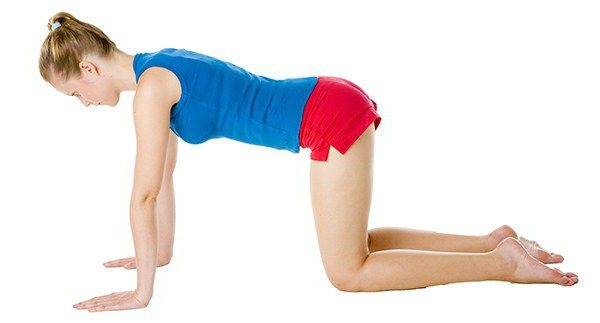
“Vacuum” for the stomach “On all fours”
We get into the starting position and perform the following actions:
- You should lean on your hands and knees, which should be exactly at right angles, respectively, under the shoulders and hips.
- The spine is straight, does not bend, does not bulge.
- The shoulder blades should be in a relaxed state, they should not be moved, the chest should be straightened.
- We make a short entrance, exhale calmly and thoroughly, until the last drop of oxygen, draw in the stomach, and hold, do it in three approaches.
All manipulations must be slow. You may notice that the “Vacuum” exercise for the abdomen, according to reviews, the results with photos are shown, allows you to solve many problems.

After mastering all the variations, you can do it everywhere, that is, keep it pulled in whenever you move or sit. In the reviews, one woman shared her experience. Every day while driving, she constantly sucks in her stomach. If you train, it will be easy, because by then the muscles will already be stronger.
The main thing is consistency, which will be the key to your success. Don't rely on quick results. According to reviews, it can be achieved in a month. But you need to understand that this depends on many factors: body type, level of physical fitness and the lifestyle you lead. If you eat poorly, drink a lot of alcohol, and spend little time on rest, of course, do not expect a positive result.
Anatomy
Your stomach has internal and external muscles.
The outer abs are the well-known abs and are trained with traditional abdominal exercises such as crunches or leg raises. The internal ones, which play the role of a natural corset, are invisible and often forgotten. But they are no less important because they support the abdominal wall and allow the stomach to remain flat and toned.
If you regularly exercise the internal muscles, they will pull the stomach inward, supporting the protruding internal organs, allowing the abs to look retracted and flat at all times, even when relaxed.
One of the most common applications is postnatal restoration (Tupler method). This technique is the most effective way to get back into shape after childbirth. The exercise also helps with many diseases of the abdominal muscles. This is especially important for women because they need to provide torso support after childbirth.
Although the exercise does not require anything more than simple breathing, it is necessary to use the correct technique, since doing it incorrectly will not benefit you.
Arnold Schwarzenegger's vacuum press method
Home > Workouts > Workouts at home > Vacuum press method by Arnold Schwarzenegger
Author: admin / Date: 2015-08-22 / Category: Home workouts

Hi all! Have you already tried everything to get amazing abs, but have not gotten the desired result? Today I will tell you about one very effective technique: a vacuum press. With its help you will have a steel press.
One of the most effective ways to burn fat in the abdominal muscles is a vacuum. Simple and effective. The technique of performing the exercise is based on several starting positions.
Feature of the vacuum exercise
The abdominal vacuum exercise is rather a combination of several techniques that must be performed in a certain way. This technique came to fitness from nauli yoga and uddiyana bandha. Similar exercises are also found in gymnastics based on aerobic breathing.
The essence of this technique is extremely simple. All that is required of you is to pull your stomach in as far as possible and hold the muscles in this position for about 20-30 seconds. But it is very important to master the breathing technique.
Any vacuum exercise is performed with a full exhalation.
This technique allows you to work the transverse abdominal muscle, which holds all the internal organs. In fact, it is precisely because of the relaxation of this muscle that the stomach looks imperfect. The fact is that when playing any sport, be it fitness or performing strength exercises, the main load falls on the external and oblique abdominal muscles. Having pumped up these muscles, the stomach, of course, will look more toned than before training, but due to the relaxed transverse muscle, it will still not be flat.
In mastering the art of holding the stomach in a complete vacuum, the most important thing is consistency. Despite the apparent simplicity of this technique, it is unlikely to be performed correctly the first time. However, do not despair, because judging by the results of people who actively engage in these exercises, after about a month of constant training, the stomach will not only be toned, but perfectly flat. This technique is often used in their training by professional bodybuilders and bodybuilders whose belly appears too large due to overtraining. A striking example of this was Arnold Schwarzenegger, who not only actively used this technique, but also complicated it a little, adding various exercises, twisting and lifting. As a result, a vacuum in the abdomen - the Schwarzenegger exercise - allows you to work the transverse muscle, at the same time eliminating fat deposits and tightening the abdominal muscles.
Starting points
The first option is the simplest and easiest to implement even in the office at work. You need to place your feet shoulder-width apart or slightly wider, with your knees slightly bent. In other words, stand on sprung legs, rest your hands on your legs (in the area just above the knee). In this position, the buttocks should be slightly back.
The second option is more suitable for the gym or home. You must lie on your back on a flat, hard surface. Bend your legs at the knees, just like for crunches.
The third option is also more suitable for the gym or training at home. Body position - face to the floor, kneeling. Arms should be straight. Otherwise, this position can be called “on all fours.” Arch your back slightly so that it is rounded.

These three body positions are the basis for starting the exercise itself.
Execution technique
The essence of the action is based on the tension of the abdominal muscles at a certain moment. Just like the positions, there are also several execution techniques. For example, one of the techniques is called friz.
- inhale air into full lungs;
- exhale the air from the lungs (completely until you feel complete emptiness, vacuum tension in the lungs)
- draw in the stomach as much as possible by tensing the abdominal muscles. This action is performed simultaneously with exhalation and must be completed completely at the moment of holding the breath.
- hold your breath for a few seconds.
Second option (the initial body position is the same):
- completely exhale the air from the lungs, then take a very small breath and hold your breath;
- while holding your breath, tense your abdominal muscles as much as possible (for a few seconds).
- after holding your breath for a few seconds, continue inhaling, repeating the same steps as indicated in the first paragraph.
- We do the above until we inhale completely. On average, a simple, untrained person splits one breath into three parts.
- We perform the same actions while exhaling.

The second option is quite complicated, despite the illusory ease of this exercise, so most trainers advise starting with the first. How to do it is up to the athlete to choose. You need to do a vacuum for the press every day. There is no specific number of approaches; it all depends on the desire and well-being of the person performing the exercise. One of the important conditions is that you can start training only on a hungry (empty stomach). This means that the best time for training is in the morning after sleep or after at least three hours after eating.
Types of “Vacuum” exercise and technique with photos
There are several options for performing a “vacuum in the stomach” and they differ in body position. There is not much difference, the choice is usually made taking into account who is more comfortable, but individual positions may turn out to be more or less difficult in terms of physical activity. In general, the position should be as comfortable as possible so that you can focus on working your abdominal muscles and not be distracted by anything else.
How to do the exercise while lying on your back
The classic version of the exercise and the most common way to perform it is in a supine position. You need to lie on a flat surface, your feet should be shoulder-width apart, and your arms should be down. To feel your movements, you can place your palms on your stomach, controlling the process.
The exercise itself is performed as follows:
- The lungs must be completely emptied of air and this can be done in two ways. The first is to simply take a smooth, deep exhalation, the second is using Bodyflex technology. To do this, a calm exhalation is done through the nose, after which the lungs are full of air, and a sharp exhalation of all the collected contents is made through the mouth with a characteristic sound;
- Next, you need to tense your abdominal muscles and try to pull them up, as if bringing them closer to the spine, and “pushing” your stomach under the ribs;
- in this position it is necessary to hold out for the recommended time;
- Afterwards, you can try to get some air without relaxing your stomach;
- then the stomach is relaxed and breathing is restored until the next cycle.
How to do it while sitting for the abdominal muscles
The complexity of this position is that the muscles that keep the spine in a straight position are also involved in the work. You can sit on a chair or any other comfortable hard and flat surface, the main thing is that your knees are bent at an angle of 90 degrees and your back is straight. You cannot lean on the back of the chair.
How to do it correctly on all fours
An exercise in a position on all fours is considered more difficult, since here you will also have to “fight” with gravity. The position itself is not difficult to take: you need to kneel, placing them shoulder-width apart, rest your hands on the floor, without bending them at the elbows. Thus, the shoulder, elbow and wrist should form one straight line perpendicular to the floor. While holding your breath, you need to tilt your head forward and arch your back slightly.
Additional recommendations
The feedback from anyone who has tried this exercise has been nothing but positive. Indeed, as a result, a person tones a large muscle block, strengthening both the rectus and oblique abdominal muscles. Due to the load, which is carried out on an empty stomach, before eating, metabolism and metabolism improves. The best result is achieved if the athlete, after training, drinks from two hundred to three hundred milliliters of water 15-20 minutes before meals. In this case, the process of burning subcutaneous fat in the waist and abdominal cavity is activated, which is the basis for achieving results. Reducing overall weight and enriching the body with oxygen is also one of the positive aspects.
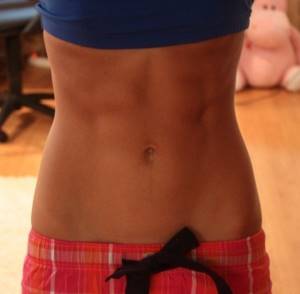
Vacuum is also recommended for women after pregnancy, as soon as a specialist allows any stress on the body. By simply alternately drawing in and inflating the abdomen with a short breath-hold, you can reduce its volume and tone your abdominal muscles.
Many of the hard, grueling exercises that professional athletes used to try to give themselves beautiful, sculpted abs do not help as much as a vacuum does. You shouldn’t work yourself until you lose consciousness and sweat to make your body beautiful. More precisely, excessive loads only harm the human body. It’s worth reading what people write who have already gone through the process of burning fat in the abdominal area, and everything will become clear. In most cases, everyone resorted to using this particular exercise.
Why is the exercise “Vacuum in the stomach” useful?
“Vacuum in the stomach” has become a popular exercise for quite some time; the well-known Arnold Schwarzenegger played a large role in its popularization. The benefits of this approach have been proven more than once; it helps to achieve a lot of positive effects:
- by burning visceral fat, the functioning of internal organs improves;
- the opportunity to get a flat stomach;
- prevention of organ prolapse and hernias by training the muscles that support
- abdominal organs in the correct position;
- improvement of the digestive process - along with the improvement in the condition of the muscles of the abdominal wall, positive changes will also occur in the intestinal walls;
- acceleration of metabolism and stimulation of the removal of harmful components from the body;
- the exercise involves proper breathing, which will enrich the entire body with oxygen in the required volume;
- improved posture;
- increased strength and vigor.


